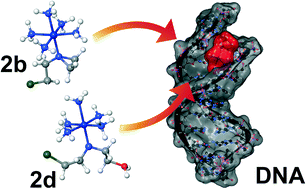A combined experimental and computational study on the interaction of nitrogen mustards with DNA†
Abstract
A complex of Co(III) with five ammine ligands and a bis(2-chloroethyl)amine moiety was prepared in an effort to understand the mechanisms of interaction of nitrogen mustards with DNA. The activity of this drug was compared to those of a similar Co(III) complex and free bis(2-chloroethyl)amine. The effect of drug interaction on DNA aggregation and condensation was investigated in aqueous solution at physiological conditions, using a constant DNA concentration (6.25 mM) and various ligand/polynucleotide (phosphate) ratios of 1/160, 1/80, 1/40, 1/20, 1/10, 1/5, 1/2, and 1/1. Fourier transform infrared, two-dimensional infrared (2D IR) and ultraviolet (UV)-visible spectroscopic methods were used to determine the ligand binding modes, the binding constants, and the stability of drug–DNA complexes in aqueous solution. Using density functional theory (DFT) calculations followed by a natural bond orbital (NBO) analysis, we examined the mechanism of interaction in four different pathways. Together with these methods, docking studies were applied to understand the features that dominate molecular orbitals, charges, and other binding parameters. The theoretical results coincided with experimental values obtained under similar conditions of pH and temperature.



 Please wait while we load your content...
Please wait while we load your content...